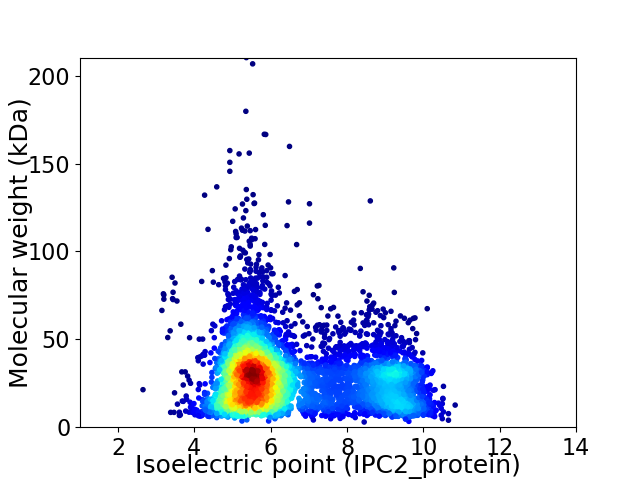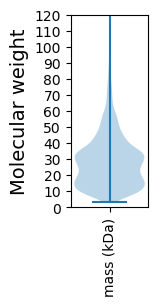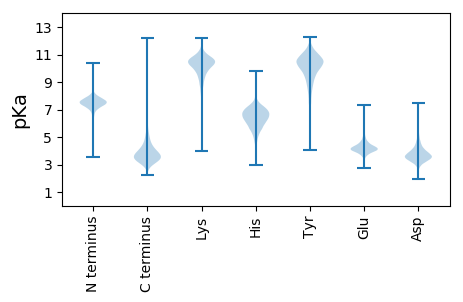
Inquilinus limosus MP06
Taxonomy: cellular organisms; Bacteria; Proteobacteria; Alphaproteobacteria; Rhodospirillales; Rhodospirillaceae; Inquilinus; Inquilinus limosus
Average proteome isoelectric point is 6.51
Get precalculated fractions of proteins

Virtual 2D-PAGE plot for 6228 proteins (isoelectric point calculated using IPC2_protein)
Get csv file with sequences according to given criteria:
* You can choose from 21 different methods for calculating isoelectric point
Summary statistics related to proteome-wise predictions



Protein with the lowest isoelectric point:
>tr|A0A0A0DEN5|A0A0A0DEN5_9PROT Lon protease OS=Inquilinus limosus MP06 OX=1398085 GN=lon PE=2 SV=1
MM1 pKa = 7.31NVNISIDD8 pKa = 3.44IPISRR13 pKa = 11.84IADD16 pKa = 3.86LVCNCFEE23 pKa = 4.44GSYY26 pKa = 10.55SPWIGSANLAPGEE39 pKa = 4.02HH40 pKa = 7.43AIPGLVFWAQPLLYY54 pKa = 8.71EE55 pKa = 4.14QPRR58 pKa = 11.84FGIVVTYY65 pKa = 10.01DD66 pKa = 3.44GPDD69 pKa = 3.44DD70 pKa = 5.04DD71 pKa = 5.09EE72 pKa = 6.94GSFASQKK79 pKa = 9.92TITLEE84 pKa = 3.84DD85 pKa = 3.45LRR87 pKa = 11.84KK88 pKa = 10.2GLEE91 pKa = 4.0LMAKK95 pKa = 9.62EE96 pKa = 4.39EE97 pKa = 4.63PYY99 pKa = 10.9QFGNFLSDD107 pKa = 3.32NDD109 pKa = 4.23DD110 pKa = 5.04AITADD115 pKa = 3.19TFMQLVVLGEE125 pKa = 4.11VVYY128 pKa = 10.79GG129 pKa = 3.79
MM1 pKa = 7.31NVNISIDD8 pKa = 3.44IPISRR13 pKa = 11.84IADD16 pKa = 3.86LVCNCFEE23 pKa = 4.44GSYY26 pKa = 10.55SPWIGSANLAPGEE39 pKa = 4.02HH40 pKa = 7.43AIPGLVFWAQPLLYY54 pKa = 8.71EE55 pKa = 4.14QPRR58 pKa = 11.84FGIVVTYY65 pKa = 10.01DD66 pKa = 3.44GPDD69 pKa = 3.44DD70 pKa = 5.04DD71 pKa = 5.09EE72 pKa = 6.94GSFASQKK79 pKa = 9.92TITLEE84 pKa = 3.84DD85 pKa = 3.45LRR87 pKa = 11.84KK88 pKa = 10.2GLEE91 pKa = 4.0LMAKK95 pKa = 9.62EE96 pKa = 4.39EE97 pKa = 4.63PYY99 pKa = 10.9QFGNFLSDD107 pKa = 3.32NDD109 pKa = 4.23DD110 pKa = 5.04AITADD115 pKa = 3.19TFMQLVVLGEE125 pKa = 4.11VVYY128 pKa = 10.79GG129 pKa = 3.79
Molecular weight: 14.21 kDa
Isoelectric point according different methods:
Protein with the highest isoelectric point:
>tr|A0A0A0D1K5|A0A0A0D1K5_9PROT LacI family transcriptional regulator OS=Inquilinus limosus MP06 OX=1398085 GN=P409_24780 PE=4 SV=1
MM1 pKa = 7.69AKK3 pKa = 8.66TAKK6 pKa = 10.02AAPAEE11 pKa = 4.21TSEE14 pKa = 4.04GRR16 pKa = 11.84CLCGRR21 pKa = 11.84VRR23 pKa = 11.84VEE25 pKa = 3.49IGVPARR31 pKa = 11.84WAWHH35 pKa = 4.99DD36 pKa = 3.19HH37 pKa = 4.96SRR39 pKa = 11.84NSRR42 pKa = 11.84LAHH45 pKa = 5.42GAAYY49 pKa = 7.77ATYY52 pKa = 8.58VGCWRR57 pKa = 11.84SRR59 pKa = 11.84VRR61 pKa = 11.84IVKK64 pKa = 10.41GEE66 pKa = 3.92SALARR71 pKa = 11.84FTEE74 pKa = 4.53EE75 pKa = 3.35EE76 pKa = 3.92TGRR79 pKa = 11.84IRR81 pKa = 11.84SFCRR85 pKa = 11.84HH86 pKa = 6.47CGTPVLYY93 pKa = 9.74EE94 pKa = 4.28RR95 pKa = 11.84PHH97 pKa = 6.36APQMVNIPRR106 pKa = 11.84ALFEE110 pKa = 4.29TRR112 pKa = 11.84TGRR115 pKa = 11.84EE116 pKa = 3.79PLYY119 pKa = 10.85HH120 pKa = 7.65IGIEE124 pKa = 4.52QARR127 pKa = 11.84EE128 pKa = 3.96WTWRR132 pKa = 11.84GEE134 pKa = 3.93PLRR137 pKa = 11.84PLKK140 pKa = 10.57GFPGVVWTGPKK151 pKa = 9.46RR152 pKa = 11.84RR153 pKa = 11.84KK154 pKa = 9.38KK155 pKa = 10.6RR156 pKa = 11.84PLLDD160 pKa = 3.33EE161 pKa = 4.62AFF163 pKa = 4.01
MM1 pKa = 7.69AKK3 pKa = 8.66TAKK6 pKa = 10.02AAPAEE11 pKa = 4.21TSEE14 pKa = 4.04GRR16 pKa = 11.84CLCGRR21 pKa = 11.84VRR23 pKa = 11.84VEE25 pKa = 3.49IGVPARR31 pKa = 11.84WAWHH35 pKa = 4.99DD36 pKa = 3.19HH37 pKa = 4.96SRR39 pKa = 11.84NSRR42 pKa = 11.84LAHH45 pKa = 5.42GAAYY49 pKa = 7.77ATYY52 pKa = 8.58VGCWRR57 pKa = 11.84SRR59 pKa = 11.84VRR61 pKa = 11.84IVKK64 pKa = 10.41GEE66 pKa = 3.92SALARR71 pKa = 11.84FTEE74 pKa = 4.53EE75 pKa = 3.35EE76 pKa = 3.92TGRR79 pKa = 11.84IRR81 pKa = 11.84SFCRR85 pKa = 11.84HH86 pKa = 6.47CGTPVLYY93 pKa = 9.74EE94 pKa = 4.28RR95 pKa = 11.84PHH97 pKa = 6.36APQMVNIPRR106 pKa = 11.84ALFEE110 pKa = 4.29TRR112 pKa = 11.84TGRR115 pKa = 11.84EE116 pKa = 3.79PLYY119 pKa = 10.85HH120 pKa = 7.65IGIEE124 pKa = 4.52QARR127 pKa = 11.84EE128 pKa = 3.96WTWRR132 pKa = 11.84GEE134 pKa = 3.93PLRR137 pKa = 11.84PLKK140 pKa = 10.57GFPGVVWTGPKK151 pKa = 9.46RR152 pKa = 11.84RR153 pKa = 11.84KK154 pKa = 9.38KK155 pKa = 10.6RR156 pKa = 11.84PLLDD160 pKa = 3.33EE161 pKa = 4.62AFF163 pKa = 4.01
Molecular weight: 18.64 kDa
Isoelectric point according different methods:
Peptides (in silico digests for buttom-up proteomics)
Below you can find in silico digests of the whole proteome with Trypsin, Chymotrypsin, Trypsin+LysC, LysN, ArgC proteases suitable for different mass spec machines.| Try ESI |
 |
|---|
| ChTry ESI |
 |
|---|
| ArgC ESI |
 |
|---|
| LysN ESI |
 |
|---|
| TryLysC ESI |
 |
|---|
| Try MALDI |
 |
|---|
| ChTry MALDI |
 |
|---|
| ArgC MALDI |
 |
|---|
| LysN MALDI |
 |
|---|
| TryLysC MALDI |
 |
|---|
| Try LTQ |
 |
|---|
| ChTry LTQ |
 |
|---|
| ArgC LTQ |
 |
|---|
| LysN LTQ |
 |
|---|
| TryLysC LTQ |
 |
|---|
| Try MSlow |
 |
|---|
| ChTry MSlow |
 |
|---|
| ArgC MSlow |
 |
|---|
| LysN MSlow |
 |
|---|
| TryLysC MSlow |
 |
|---|
| Try MShigh |
 |
|---|
| ChTry MShigh |
 |
|---|
| ArgC MShigh |
 |
|---|
| LysN MShigh |
 |
|---|
| TryLysC MShigh |
 |
|---|
General Statistics
Number of major isoforms |
Number of additional isoforms |
Number of all proteins |
Number of amino acids |
Min. Seq. Length |
Max. Seq. Length |
Avg. Seq. Length |
Avg. Mol. Weight |
|---|---|---|---|---|---|---|---|
0 |
1722682 |
26 |
1966 |
276.6 |
29.84 |
Amino acid frequency
Ala |
Cys |
Asp |
Glu |
Phe |
Gly |
His |
Ile |
Lys |
Leu |
|---|---|---|---|---|---|---|---|---|---|
13.301 ± 0.041 | 0.796 ± 0.009 |
5.84 ± 0.028 | 5.268 ± 0.027 |
3.571 ± 0.017 | 9.208 ± 0.034 |
1.966 ± 0.016 | 4.88 ± 0.024 |
2.547 ± 0.026 | 10.609 ± 0.04 |
Met |
Asn |
Gln |
Pro |
Arg |
Ser |
Thr |
Val |
Trp |
Tyr |
|---|---|---|---|---|---|---|---|---|---|
2.259 ± 0.014 | 2.14 ± 0.018 |
5.657 ± 0.021 | 3.047 ± 0.018 |
7.588 ± 0.033 | 4.707 ± 0.019 |
5.216 ± 0.021 | 7.715 ± 0.024 |
1.478 ± 0.015 | 2.206 ± 0.016 |
Most of the basic statistics you can see at this page can be downloaded from this CSV file
Proteome-pI is available under Creative Commons Attribution-NoDerivs license, for more details see here
| Reference: Kozlowski LP. Proteome-pI 2.0: Proteome Isoelectric Point Database Update. Nucleic Acids Res. 2021, doi: 10.1093/nar/gkab944 | Contact: Lukasz P. Kozlowski |
